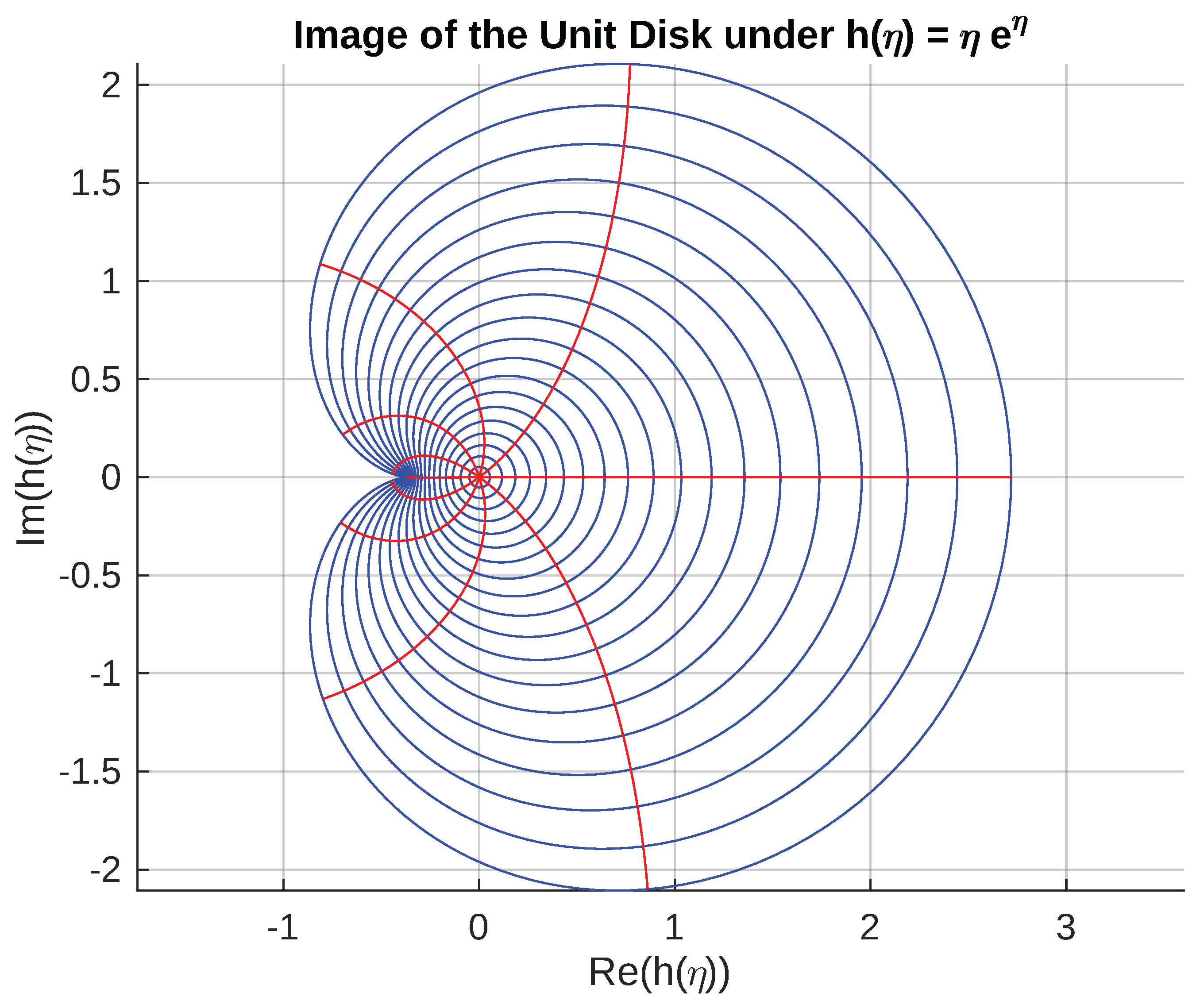Geometric Characteristics of Specific Classes Associated with q-Janowski Functions
Abstract
1. Introduction
- 1.
- ,
- 2.
- 3.
2. Main Results
-Neighborhoods for Functions in the Classes and
- ForIn Definition 3, the neighborhood corresponding to the classes is defined as and which is .
- By setting in Definition 3, we obtain the definition of the neighborhood associated with the q-derivative, denoted by and , where is defined in Equation (3).
- Step 1.
- Step 2.
- Step 3.
3. Conclusions
Author Contributions
Funding
Data Availability Statement
Conflicts of Interest
References
- Ruscheweyh, S. Neue Untermengen der schlichten Funktionen. Comment. Math. Helv. 1975, 50, 515–531. [Google Scholar]
- Janowski, W. Some extremal problems for certain families of analytic functions. Ann. Pol. Math. 1973, 28, 297–326. [Google Scholar] [CrossRef]
- Jackson, F.H. On q-functions and a certain difference operator. Trans. R. Soc. Edinb. 1909, 46, 253–281. [Google Scholar] [CrossRef]
- Jackson, F.H. On q-definite integrals. Q. J. Pure Appl. Math. 1910, 41, 193–203. [Google Scholar]
- Mourad, E.; Ismail, H.; Merkes, E.; Styer, D. A generalization of starlike functions. Complex Var. Theory Appl. 1990, 14, 77–84. [Google Scholar] [CrossRef]
- Naeem, M.; Hussain, S.; Khan, S.; Mahmood, T.; Darus, M.; Shareef, Z. Janowski type q-convex and q-close-to-convex functions associated with q-conic domain. Mathematics 2020, 8, 440. [Google Scholar] [CrossRef]
- Srivastava, M.; Tahir, M.; Khan, B.; Ahmad, Z.; Khan, N. Some general classes of q-starlike functions associated with the Janowski functions. Symmetry 2019, 11, 292. [Google Scholar] [CrossRef]
- Alsarari, F.; Alzahrani, S. Convolution Properties of q-Janowski-Type Functions Associated with (x,y)-Symmetrical Functions. Mathematics 2022, 14, 1406. [Google Scholar] [CrossRef]
- Govindaraj, M.; Sivasubramanian, S. On a class of analytic functions related to conic domains involving q-calculus. Anal. Math. 2017, 43, 475–487. [Google Scholar] [CrossRef]
- Cotîrlǎ, L.-I.; Murugusundaramoorthy, G. Starlike Functions Based on Ruscheweyh q-Differential Operator defined in Janowski Domain. Fractal Fract. 2023, 7, 148. [Google Scholar] [CrossRef]
- Purohit, S.; Murugusundaramoorthy, G.; Vijaya, K.; Suthar, D.; Jangid, K. A Unified Class of Spiral-like Function Including Kober Fractional Operators in Quantum Calculus. Palest. J. Math. 2023, 2, 487–498. [Google Scholar]
- Breaz, D.; Murugusundaramoorthy, G.; Cotîrlǎ, L.-I. Geometric Properties for a New Class of Analytic Functions Defined by a Certain Operator. Symmetry 2022, 14, 2624. [Google Scholar] [CrossRef]
- Khan, B.; Liu, Z.G.; Shaba, T.G.; Araci, S.; Khan, N.; Khan, M.G. Applications of q-Derivative Operator to the Subclass of Bi-Univalent Functions Involving -Chebyshev Polynomials. J. Math. 2022, 2022, 8162182. [Google Scholar] [CrossRef]
- Srivastava, M. Operators of Basic (or q-) Calculus and Fractional q-Calculus and Their Applications in Geometric Function Theory of Complex Analysis. Iran. Sci. Technol. Trans. Sci. 2020, 44, 327–344. [Google Scholar] [CrossRef]
- Polatoglu, Y. Growth and distortion theorem for the Janowski alpha-spirallike functions in the unit disc. Stud. Univ.-BabeS-Bolyai Math. 2012, 57, 255–259. [Google Scholar]
- Agrawal, S.; Sahoo, S.K. A generalization of starlike functions of order alpha. Hokkaido Math. J. 2017, 46, 15–27. [Google Scholar] [CrossRef]
- Robertson, M.S. On the theory of univalent functions. Ann. Math. 1936, 37, 374–408. [Google Scholar] [CrossRef]
- Nevanlinna, R. Uber Uber die konforme abbildung sterngebieten. Oversikt av Finska-Vetenskaps-Soc. Forh 1920–1921, 63A 6, 1–21. [Google Scholar]
- Goodman, A.W. Univalent functions and nonanalytic curves. Proc. Am. Math. Soc. 1975, 8, 598–601. [Google Scholar] [CrossRef]
- Ruscheweyh, S. Neighborhoods of univalent functions. Proc. Am. Math. Soc. 1981, 81, 521–527. [Google Scholar] [CrossRef]
- Ruscheweyh, S.; Sheil-Small, T. Hadamard products of Schlicht functions and the Polya-Schoenberg conjecture. Comment. Math. Helv. 1979, 48, 119–135. [Google Scholar] [CrossRef]
- Ganesan, M.; Padmanabhan, K.S. Convolution conditions for certain classes of analytic functions. Int. J. Pure Appl. Math. 1984, 15, 777–780. [Google Scholar]
- Silverman, H.; Silvia, E.M.; Telage, D. Convolution conditions for convexity, starlikeness and spiral-likeness. Math. Z. 1978, 162, 125–130. [Google Scholar] [CrossRef]

Disclaimer/Publisher’s Note: The statements, opinions and data contained in all publications are solely those of the individual author(s) and contributor(s) and not of MDPI and/or the editor(s). MDPI and/or the editor(s) disclaim responsibility for any injury to people or property resulting from any ideas, methods, instructions or products referred to in the content. |
© 2025 by the authors. Licensee MDPI, Basel, Switzerland. This article is an open access article distributed under the terms and conditions of the Creative Commons Attribution (CC BY) license (https://creativecommons.org/licenses/by/4.0/).
Share and Cite
Alsarari, F.; Darem, A.; Touati, A.; Alzulaibani, A.A. Geometric Characteristics of Specific Classes Associated with q-Janowski Functions. Axioms 2025, 14, 696. https://doi.org/10.3390/axioms14090696
Alsarari F, Darem A, Touati A, Alzulaibani AA. Geometric Characteristics of Specific Classes Associated with q-Janowski Functions. Axioms. 2025; 14(9):696. https://doi.org/10.3390/axioms14090696
Chicago/Turabian StyleAlsarari, Fuad, Abdulbasit Darem, Amel Touati, and Alaa Awad Alzulaibani. 2025. "Geometric Characteristics of Specific Classes Associated with q-Janowski Functions" Axioms 14, no. 9: 696. https://doi.org/10.3390/axioms14090696
APA StyleAlsarari, F., Darem, A., Touati, A., & Alzulaibani, A. A. (2025). Geometric Characteristics of Specific Classes Associated with q-Janowski Functions. Axioms, 14(9), 696. https://doi.org/10.3390/axioms14090696






